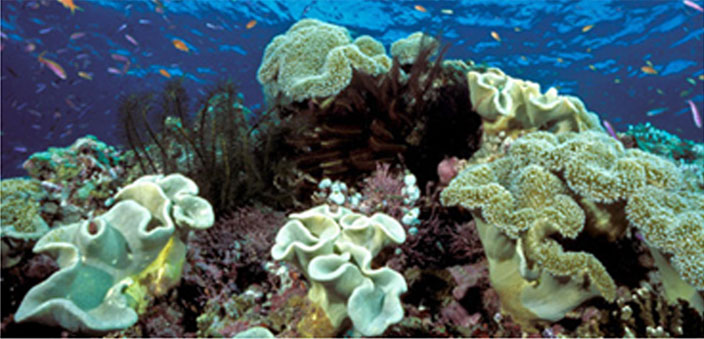AJacques Cousteau very aptly said that, “Water and air, the two essential fluids on which all life depends, have become global garbage cans”.
As school going children, while learning geography, the most astounding topic was the beauty of the coral reefs. This marvelous bounty of weird shapes, sizes, colour and texture, thriving in the turquoise depths of the oceans and seas has been an attraction to man for generations now. It is said the oldest coral reef dates back to 500 million years, which means its creation is still a mystery.
How are coral reefs formed?
Corals are diverse ecosystems formed underwater, which are held together by an exoskeleton of calcium carbonate (CaCO3). This CaCO3 is secreted by the corals which support and protect the polyps from which the coral is formed. Coral reefs are also built by colonies of tiny marine animals in cluster groups. These animals can include sea anemones and jellyfish. Though this ‘rainforest of the sea” occupies only 0.1 percent of the world ocean surface, it is home to nearly 25 percent of marine life.

Along with being a wonder of the world, the coral reefs are a major tourist attraction in many places. Corals need sunlight, clean water, warm water temperature and salt water to thrive. All of these in essentially adequate amounts can ensure that the reef blossoms and blooms.
The withering away
What has caused this bountiful formation to wither away? Tourism, oil spills, and climate change have played a major role in the mass depletion of this natural marvel. It is a known fact that since industrial revolution, human intervention and its effect on biodiversity are clearly visible today. From thunderstorms and flash floods in monsoons, to dry, hot and scorching summers, to blizzards in winter, to depletion of marine ecologies and life in water, to ocean acidification and calcification of coral reefs, man plays a pivotal role in causing this damage.
AquaView, an online scuba magazine wrote in 2013 that “As coastal construction increases and global temperatures rise, an estimated 33 percent of corals are in danger of extinction. Marine studies have shown an 80 percent decline in some forms of coral over the last decade”.
Corals cannot survive if the water temperature is too high. Global warming has already led to increased levels of coral bleaching, and this is predicted to increase in frequency and severity in the coming decades. Such bleaching events may be the final nail in the coffin for the already stressed coral reefs and ecosystems. Climate change is a grave and perilous problem that is looming large and causing major damage to life.
Encroachment on land is something that doesn’t surprise us, but the fact that live coral is removed from reefs for use as bricks, road-fill, or cement for new buildings, is astounding. Corals are sold as souvenirs to tourists and to exporters who don’t know or don’t care about the long term damage done, and they are harvested for live rock trade.
Pollution is another major reason for the depletion of coral reefs. Urban and industrial waste, sewage, agrochemicals are freely let out into open waters. These toxins dumped directly into the ocean or carried by river systems from sources upstream damage the reefs. Some pollutants, such as sewage and runoff from farming, increase the level of nitrogen in seawater, causing an overgrowth of algae, which smothers reefs by cutting off their sunlight.
Tourism can be as major a hindrance as encroachment, with activities like careless boating, diving, snorkeling, and fishing that happens across the globe, it is definitive that marine life is adversely affected by it. With people touching reefs, stirring up sediment, collecting coral, and dropping anchors on reefs, we have accelerated the rate of extinction of these reefs. Some tourist resorts and infrastructure have been built directly on top of reefs, and some resorts empty their sewage or other wastes directly into water surrounding coral reefs. What are we doing?
Oil spills from major and minor fishing vessels and VLCs (Very Large Containers) cause oil slick to coat the top layer of the water. Since the oil is denser than water, it becomes impossible for sunlight to penetrate through the oil layer, thereby causing the temperature to drop inside the water, making it difficult for the coral reef to thrive. Even the slightest difference in temperature can cause damage to the coral reef.
Exposing corals to small amounts of oil for an extended period can be just as harmful as large amounts of oil for a brief time.
Coral reefs come in contact with oil in three ways:
Once oil comes into contact with corals, it can kill them or impede their reproduction, growth, behaviour, and development. The entire reef ecosystem can suffer from an oil spill, affecting the many species of fish, crabs, and other marine invertebrates that live in and around coral reefs.
How can we make a difference?
A nature conservancy organisation based in Arlington (Texas), USA, has provided us with some simple ways which each of us may practice to slow down the rate, and eventually end the threat of extinction of coral reefs across the globe:


 [/column]
[/column]